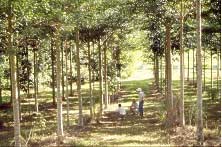|
|
|
An
alternative approach to farm forestry development
If farm forestry is to help meet the needs
and aspirations of all, effective strategies must be developed
to identify opportunities and engage farmers and stakeholders.
Strategies need to take advantage of the potential of forestry
to contribute to the development of more resilient rural landscapes.
Instead of promoting single-purpose forestry options, stakeholders
seeking particular outcomes, such as timber production, land
degradation control or biodiversity, must try and marry their
needs to those of farmers. For example, research suggests that
for many farmers, being able to hand their farm over to their
children in a better condition than they found it and farming
within the environmental capacity of the land are important
goals. Those stakeholders who are able to demonstrate how growing
trees can help meet these aspirations are more likely to be
welcomed by farmers.
Research by ABARE has shown that farmers who plant trees are
primarily motivated by a desire to provide shelter for stock
and crops, address land degradation and enhance wildlife habitat.
Farmers rarely talk about their trees underpinning future timber
supplies, reducing water treatment costs, reducing the trade
deficit, or providing an alternative wood supply to native forests.
These are the concerns of other stakeholders - stakeholders
who do not own the farmland on which they would like to see
trees grown.

Forestry clearly has a role to play in meeting
many farmers’ needs and aspirations. However, it is unlikely
that they will unconditionally accept the "best-bet"
options advocated by single-interest groups. A more successful
strategy might be for government, industry, conservation groups
and water authorities to see themselves as the farmers’
clients or customers. If farmers design and manage their forests
to better meet the interests of these customers, they may be
able to negotiate attractive rewards for providing the forestry
products and environmental or social services others are seeking.
The rewards may come in many forms including:
• higher prices for forest products
• stewardship payments for providing environmental services
• rate rebates
• planning support
• grants
• special privileges
• marketing assistance
• invitations to participate in joint ventures.
The key is to allow farmers
to retain the ownership and responsibility for land use decisions
thereby encouraging innovation in design and opportunities for
multipurpose production.
Australian farmers are highly regarded for
modifying and adopting farming innovations to suit their needs
and markets. By working with potential customers to find out
what they want, farmers can consider farm forest designs that
will deliver high quality products and services. This enables
them to balance the likelihood of future sales with their own
priorities before committing to a specific forest design. Purchasers
can help by describing their product requirements and negotiating
a price and point-of-sale agreement that encourages farmers
to consider the most appropriate forest designs.
Farmers can service several different customers. For example,
high value sawlogs don't need to be grown in a dedicated sawlog
plantation – they could be grown in a wildlife corridor
or a shelterbelt. The purchaser can benefit from this. They
pay only for the outcomes they require, rather than the full
cost of establishing and managing single purpose forests.
Penalties, like incentives, are another legitimate tool that
governments and others can use to encourage farmers to pursue
a specific outcome. For example, harvesting contractors often
penalise farmers for the increased costs associated with harvesting
small or difficult areas. Some local governments are introducing
differential rating to offer rate rebates to farmers prepared
to protect native forests or establish multipurpose farm forestry.
In some areas they increase rates on industrial plantations
that they believe are not contributing to their vision for the
shire. Governments are also able to enact regulations and enforce
codes of practice that can have a similar effect.
To be effective in encouraging farmers to develop efficient
and innovative farm forestry designs and be committed to forest
management and maintenance, any incentives, payments, penalties,
regulations and codes of practice should focus on rewarding
those who deliver the outcomes stakeholders are after. For example,
land protection grants that simply pay for the seedlings and
tree guards provide no guarantee that a forest will be capable
of improving water quality or reducing soil erosion. Providing
direct financial rewards to farmers who successfully establish
a forest that provides real land protection values might be
expected to result in greater efficiency and better rewards.
In the same way, codes of practice that do not permit the harvesting
of timber from stream reserves or native forests because of
the anticipated environmental impacts may actually encourage
neglect by discouraging revegetation and maintenance.
The wider community must recognise and accept that it is the
farmers who make the final decision about the establishment
and management of forests on their land. Farm forestry’s
future in Australia depends on what forestry can do to support
the needs and aspirations of the farming community and interest
groups’ willingness to pay farmers for their preferred
outcomes. With appropriate strategies, farm forestry will be
able to evolve into an integral part of Australia’s farming
landscape rather than replace it.
Back to top
|
|
